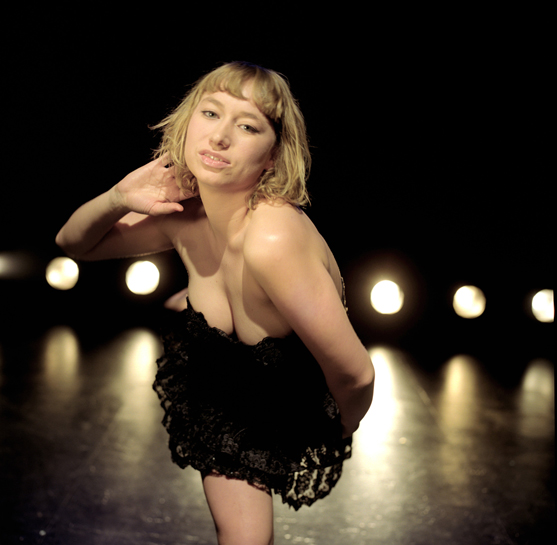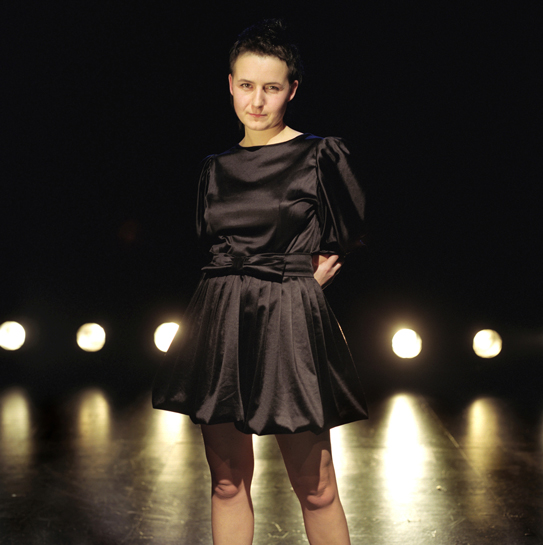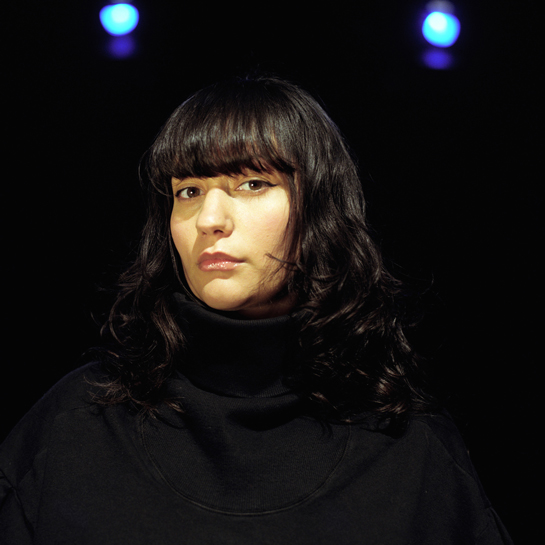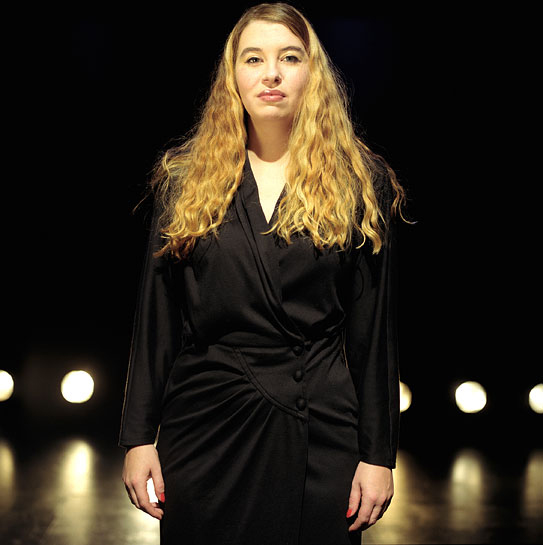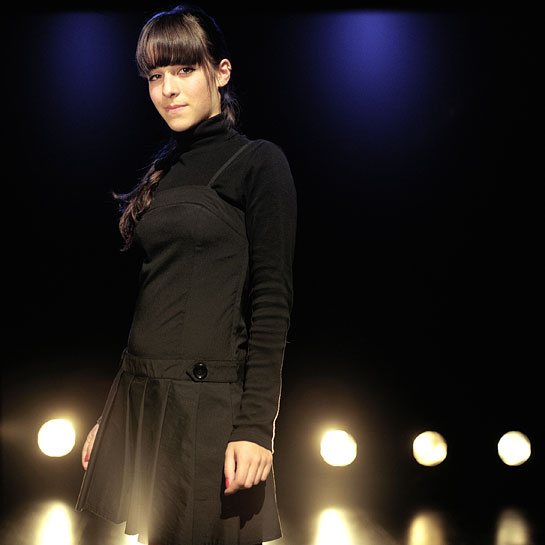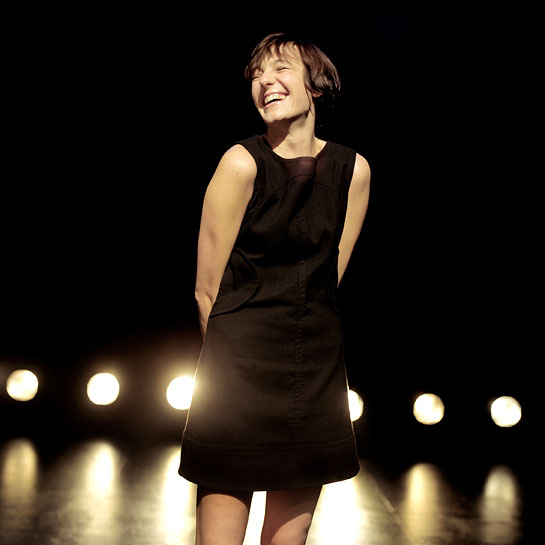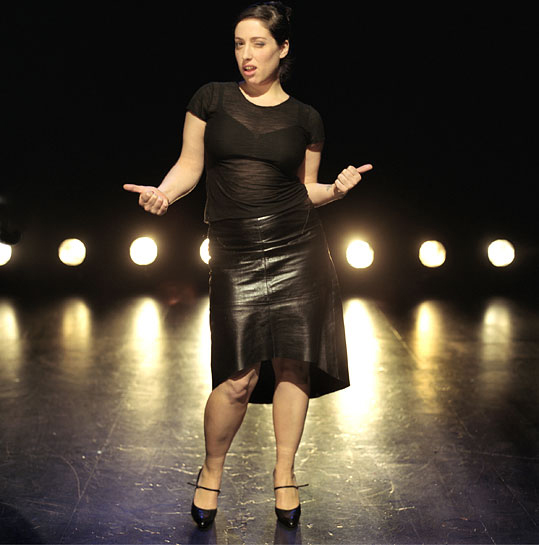«SHOW DANCE»: ALEXANDRA BACHZETSIS SHOWS US THE ROPES
Imagine, for a minute or two, walking into a Helmut Newton photo shoot. And not of any old photograph, but of one of the great man’s most riveting, iconic images – that of “Here They Come”, a picture of four women (stark naked, naturally – except for their indispensable stilettos) haughtily strutting towards the camera: a photographic monument of ambiguity, representing “powerful women in all their naked truth”, self-confidently parading before the eye of Newton’s notoriously voyeuristic camera. Whether or not this parade was shot through with parody – hence the ambivalence, hence the image’s appeal to “gender trouble” – the imperious, muscular force of this fierce foursome clearly derives from their formation: four ‘individuals’ arranged in a phalanx of Amazon self-awareness. This is what I think of upon witnessing Show Dance by Alexandra Bachzetsis; I do not know whether Newton’s genre-defining image was ever on the choreographer’s mind while hatching out the plotlines of Show Dance – the piece has a definite narrative streak – and of course it doesn’t matter whether it was or not, but the mere fact of this insinuation in some sense attests to Bachzetsis’ uncanny feel for excavating images of female self-empowerment from even the murkiest of depths of “male gazing” (it may be hard to imagine now, in these truly pornocratic times, but once upon a time Newton’s photography was evidently targeted as a classic example of sadist domination). Show Dance is Bachzetsis’ most emphatically, cheerily theatrical celebration of Womanhood to date – a tightly choreographed parade of ‘strong’, i.e. self-conscious women who take turns ‘showing’ off in front of an enraptured audience before finally converging in a dazzling ensemble routine that brings to mind both Newton’s landmark image as well as Busby Berkeley’s kaleidoscopic showgirl choreographies and the unending string of video-clips they continue to inspire to this day (Feist’s “1, 2, 3, 4” is a particularly engaging recent example). The women number twelve in total, and the great majority of them are anything but professional dancers – which of course enables Bachzetsis to paint a far more comprehensive, colorfully varied portrait of Woman than is usually ‘allowed’ for by the specific rigors of the world of dance and performance; they are ‘real’ in a way that is both refreshing and revealing to an audience that is probably accustomed to a highly manicured, skewed image of femininity, and this realism is of course integral to the piece’s immediate appeal – I truly know of very few dance pieces that elicit the same kind of raucously enthusiastic audience response as Show Dance. Yet there is also a great deal of ‘sameness’ in the piece, represented most ostensibly by the fact that each dancer emerges from the curtains at the back of the stage clad in a leveling black outfit that only differs minimally from that of her predecessor – an inclination towards the monolithic that of course reaches its apogee in Show Dance’s sumptuous final, the military precision of which conjures up images of 80s power dress fashion runways – the original machines for producing ‘identity’ (as opposed to ‘difference’) in women. As is usual in Bachzetsis’ practice, defined in no small part by collaborative work, music plays an important part in Show Dance; musical director Lies Van Born lays down the soundtrack to each individual dance routine, offering a range of dancehall classics such as Peggy Lee’s “Fever” and vintage tearjerkers such as “Dag vreemde man” by Belgian torch song legend Ann Christy, before finally also taking to the dancefloor herself. The dance routines themselves vary wildly in style, execution and narrative ‘content’, reflecting (or not!) the dancer’s temperament; the palette of womanhood thus presented comprises the extremes of Lolita naiveté on the one hand and raunchy abandon on the other, of femme fatale-styled self-control and melancholy stupor. Then follows a transitory moment of contemplation and befuddled ennui in which all the dancers gather on stage and seem wholly consumed by their own thought worlds – the one moment we see twelve women “together apart” just before they rev up in the sweeping hoopla of the piece’s final chapter, and they once again become “Newton’s women”, self-consciously meeting the audience’s hungry gaze: a joyous paean to the art of “becoming woman” that requires an appropriate toast – of Champagne, of course, served to us by strapping young lads in matching dark suits.
CONCEPT AND CHOREOGRAPHY Alexandra Bachzetsis // PERFORMED BY Lies Vanborm, Ann Demeester, Danai Anesiadou, Elke Vanlerberghe, Annemie Goegebuer, Daphni Antoniou, Elsmieke Scholte, Ayelen Parolin, Gosie Vervloessem, Alexandra Bachzetsis, Anat Stainberg,Barbara Raes, Otobong Nkanga, Helga Duchamps // CHAMPAGNE Michael Bussaer, Michel Quéré // TECHNIQUE Kwinten Lavigne/Danny Vandeput // MUSIC Lies Vanborm // PRODUCTION/MANAGEMENT Helga Duchamps, Duchamps vzw, Brussel // SUPPORTED BY Pro-Helvetia, Arts Council of Switzerland // PHOTOS Caroline Minjolle – not to be reproduced
